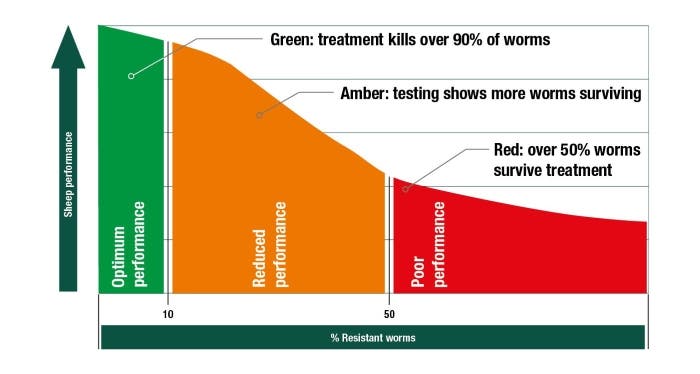Protecting the future of UK sheep farming
Worm resistance is a problem that the vast majority of sheep farmers are all too familiar with. The problem is that the signs and symptoms are visible only after the damage is done and productivity and performance have already been affected.
In 2020, NSA, Moredun, SVS, SCOPS joined together to urge sheep farmers to incorporate the new wormer actives (4-AD, monepantel, Zolvix™ and 5-SI) into their worm control plans. Read the information in full.
Incorporating a 4-AD wormer like Zolvix is an investment not just for short-term results, such as fatter and healthier lambs, but for the long-term well-being of both flock and farm, helping to safeguard your legacy for future farming generations and the UK sheep farming industry as a whole.

What is anthelmintic resistance?
Anthelmintic resistance is the ability of worms to survive the normal dose of a wormer and pass that ability on to its offspring. This results in the proportion of resistant worms in the population increasing over time. Worms can be resistant to one class or several classes of wormer.
The percentage of resistant worms, and the number that survive treatment, increases with time as illustrated:


What is the impact of anthelmintic resistance?
The impact of wormer resistance on the farm will not be immediately obvious. As resistance develops, there is a gradual increase in the number of worms surviving treatment. The worms left behind will hold the lambs back, decreasing growth rates by up to 50% before there are any visible signs that the wormer treatment has not been fully effective1. The level of challenge, and therefore the need to treat for these worms during the summer and autumn, is weather dependent.
- Even low levels of resistance can leave enough worms behind to affect growth rates. Indeed, when the number of resistant worms is more than 10%, we start to gradually lose lamb performance because enough worms can be left behind to reduce growth rates3.
- A low to moderate worm burden can reduce growth rates by up to 50% without any obvious clinical signs3.
This is why we need to change current practices and adopt a more sustainable approach to worm control - even when there are no visible signs of decreased performance or lack of wormer efficacy.

Why is anthelmintic resistance a problem?
Anthelmintic resistance is one of the biggest challenges to the health and profitability of sheep and affects the entire sheep industry: a recent study found that parasitic worms has been estimated to cost the European livestock industry more than €1.8 billion per year, with drug-resistance costing at least €38 million per year in production losses and treatment costs.3,4

In the last 10 years the number of reports of resistance to the three older classes have been increasing. Research from Wales Against Anthelmintic Resistance Development (WAARD) showed the majority of farms surveyed had a degree of resistance to two or more of the older wormer classes1.
This not only means that overuse of the three older classes will continue to expedite the development of resistance, but also means that farmers are not seeing a true return on their investment in their flock.
Once anthelmintic resistance has developed, it is not reversible, so we need to do everything possible to slow the development of resistance.

What can we do about anthelmintic resistance?
Once anthelmintic resistance has developed, it is not reversible, so we need to do everything possible to slow the development of resistance.
The speed at which resistance develops depends on how carefully and sustainably anthelmintics are used. This means avoiding practices that drive resistance development, such as:
- treating sheep when the refugia population (ie those worms not exposed to the wormers) is small: for example, dosing animals and moving immediately to clean pasture; dosing the whole group in the winter, eg ewes at lambing time, when the worm population on the pasture is low.
- under-dosing animals: weigh the animals, calibrate the dosing gun and dose to the heaviest animal in the group.
- over-using wormers: move from routine dosing to routine monitoring. Lambs should only be treated when their worm burden reaches the point where it starts to decrease their growth rate; the same wormer group should not be used repeatedly or for consecutive treatments; and the newer group 4-AD (Orange) and group 5-SI (Purple) wormers should be used in every flock6 at the right time. As one of the newer groups, Zolvix™, the group 4-AD wormer, should be used in every flock, every year.
It's always best to check how effective a treatment has been by doing a post-treatment drench check, with a faecal egg count, after every treatment.

What are sheep farmers saying?
A farmer survey5 showed that 86% of farmers thought their wormers were working as well as they always had. The same survey showed that the majority of farmers judged this on “the look and condition of the sheep”.
However, data shows that lamb performance/growth rate will be reduced by up to 50%2 by a worm burden (e.g. resistant worms left behind after treatment), with no visible sign that the lambs are unhealthy.
Worm resistance is an invisible problem, only becoming visible when it's too late.
Farmers incorporating Zolvix™ in their worm control strategy have found its efficacy at managing worm burdens means their lambs achieve the target growth rates:

See the difference that using Zolvix has made to farmers Caryl, Gregor and Neil, and why they genuinely believe Zolvix is Worth Every Penny.
Find out more about managing worms in sheep
- Wales Against Anthelmintic Resistance Development (WAARD) Final Report 2015.
- SCOPS Internal Parasite Technical Manual
- Initial assessment of the economic burden of major parasitic helminth infections to the ruminant livestock industry in Europe – ScienceDirect
- Preventive Veterinary Medicine, Vol 182, September 2020, 105103
- National Farm Research Institute Market Research 2021 Zolvix Brand Health and Key Messages for Farmers
- SCOPS Using Group 4-AD and Group 5-SI anthelmintics
